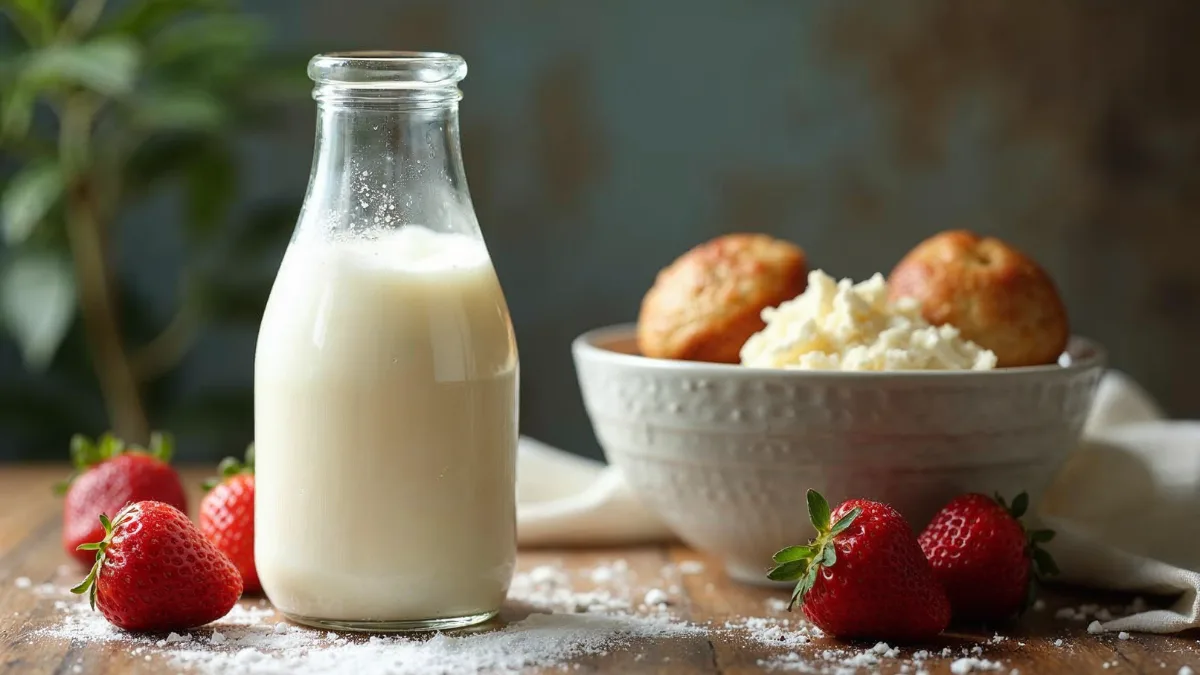When it comes to baking, finding healthier alternatives to common ingredients can be a game-changer. One such option is kefir, a tangy, probiotic-rich dairy product that has been gaining popularity in the world of baking. Traditionally used in smoothies and as a drink, kefir has begun to make its way into muffin recipes, replacing regular milk. The question many bakers ask is: Can I use kefir instead of milk in muffins?

The short answer is yes—kefir can be used as a substitute for milk in muffins. However, while it works as a one-to-one replacement, there are a few key differences to consider. Kefir’s distinct tangy flavor may influence the overall taste of your muffins, providing a slightly sour note. Additionally, kefir is thicker than milk, which can result in a denser texture in the final baked product. Despite these differences, kefir offers several health benefits, including probiotics that support digestion, and can add moisture and richness to your muffins.
In this article, we will explore how kefir can be used in muffin recipes, its effects on texture and flavor, and tips for ensuring successful results.
The Benefits of Using Kefir in Muffins
Kefir, often hailed as a superfood, is not just a great addition to your daily diet but also an excellent ingredient to incorporate into baked goods like muffins. By swapping regular milk with kefir, you’re not only changing the flavor profile but also boosting the nutritional value of your muffins.
Probiotic Power: Kefir’s Benefits for Gut Health
One of the standout benefits of kefir is its probiotic content. Probiotics are live bacteria that promote a healthy gut microbiome, which can lead to improved digestion and immune function. Consuming probiotics regularly, especially in baked goods like muffins, may help balance gut bacteria, alleviate digestive issues, and support overall digestive health. By replacing milk with kefir, you’re giving your muffins a gut-friendly twist, making them a healthier snack choice.
A Moist Muffin: How Kefir Affects Texture
In addition to its health benefits, kefir can also have a significant impact on the texture of your muffins. Since kefir is thicker and more acidic than regular milk, it contributes to a moist and slightly denser texture. The acidity in kefir also helps activate baking soda, resulting in a fluffier and lighter crumb in your muffins. This means that muffins made with kefir are not only healthier but also have a pleasingly moist and tender texture, making them a great choice for anyone looking to create a more nutritious muffin without sacrificing taste or texture.
How Does Kefir Affect Muffin Texture and Taste?
When it comes to baking, kefir introduces both flavor and texture changes that can alter the overall outcome of your muffins. Due to its tangy flavor and slightly thicker consistency compared to regular milk, kefir influences both the taste and texture in noticeable ways.
The Impact of Acidity on Texture
The acidity in kefir interacts with baking soda or baking powder, often making the batter slightly denser. This acidity can result in a moist and slightly heavier muffin compared to muffins made with milk, which tend to have a lighter texture. While some may appreciate the richer, denser feel, others might find it a bit heavier, especially when compared to traditional lighter muffins.
Flavor Pairings: Complementing Kefir’s Tang
In terms of flavor, kefir’s distinct tanginess can introduce a subtle sourness to your muffins. This can actually complement certain flavor profiles. For example, fruity muffins (such as blueberry or banana) or muffins with spices (like cinnamon or nutmeg) can pair beautifully with kefir, as the tang adds a layer of complexity. The slight sourness contrasts well with the sweetness of fruit or balances the warmth of spices, creating a more nuanced flavor.
While kefir may not be ideal for every type of muffin (especially those that rely on a sweet, mild base), it offers a unique twist when paired with flavors that can complement its tangy undertones.
How to Substitute Kefir for Milk in Muffins
Substituting kefir for milk in muffin recipes is straightforward, and the 1:1 substitution ratio generally works well. However, there are a few adjustments you might want to consider to ensure the best results.
Kefir vs Milk: Substitution Tips
When replacing milk with kefir, simply use an equal amount of kefir as you would milk. For instance, if your recipe calls for 1 cup of milk, you can substitute it with 1 cup of kefir. The tangy flavor of kefir will add a unique twist to the taste, but the texture will remain fairly similar. Since kefir is thicker than milk, it can help make your muffins a bit denser and moister.
However, because kefir is more acidic than milk, it’s important to keep that in mind when working with other ingredients. If your recipe already includes acidic ingredients like lemon juice or vinegar, you might want to reduce these slightly to avoid an overly tangy or too dense result. The acidity from the kefir will already interact with the leavening agents, so cutting back on other acidic ingredients will help maintain the balance.
Adjusting Ingredients for Better Results
In some recipes, you might also need to slightly adjust the liquid-to-dry ingredient ratio. Since kefir is thicker than milk, your batter might be a bit thicker than expected. If the mixture seems too dry, you can add a small amount of water or a non-dairy liquid (like almond milk) to loosen the batter. Conversely, if the batter becomes too runny, a slight increase in flour may be needed.
By making these minor adjustments, you can successfully substitute kefir for milk in your muffin recipes while maintaining great texture and flavor.
Potential Drawbacks of Using Kefir in Muffins
While kefir can offer some unique benefits in muffin recipes, there are a few potential drawbacks to consider. One of the main concerns is kefir’s tangy taste, which may not be to everyone’s liking. The distinct sourness of kefir can alter the flavor profile of your muffins, and if you’re someone who prefers a milder, sweeter muffin, the tang might feel overwhelming, especially if you’re not used to kefir’s flavor.
Additionally, kefir can make your muffins slightly denser than those made with milk. This is due to its thicker consistency and acidity, which interact with leavening agents to produce a heavier texture. While some people enjoy this denser, moist muffin, others might prefer a lighter, airier result. For those who like a fluffier texture in their muffins, kefir might not be the best choice, as it could alter the desired outcome, making the muffin less light and more compact.
Lastly, kefir’s acidity could potentially conflict with recipes that already include acidic ingredients, like vinegar or citrus, leading to a more pronounced sour taste. Therefore, it’s important to balance these elements when using kefir in muffins.
Can You Use Non-Dairy Kefir as a Milk Substitute in Muffins?
Non-dairy kefir, made from alternatives like coconut, almond, or soy, can also be used as a substitute for milk in muffin recipes. These non-dairy options provide the same probiotic benefits as traditional kefir, making them an excellent choice for vegan or lactose-intolerant bakers. By using non-dairy kefir, you can maintain the gut-friendly advantages while accommodating dietary preferences or restrictions.

Non-Dairy Kefir for Vegan Muffins
For vegan bakers or those avoiding dairy, non-dairy kefir provides a great alternative to traditional kefir or milk. Since it’s plant-based, non-dairy kefir contains no lactose, making it a suitable option for individuals with lactose intolerance. Additionally, non-dairy kefir can be found in several varieties, including coconut, almond, and soy, each offering unique flavors and textures. It’s ideal for creating a vegan-friendly muffin, maintaining the probiotics found in traditional kefir without the need for animal-derived ingredients. Just be sure to check that the non-dairy kefir is labeled as “unsweetened” to avoid adding unnecessary sugar to your muffins.
Flavor and Texture Differences in Non-Dairy Kefir
Although non-dairy kefir shares the tangy properties of regular kefir, the flavor and texture can differ depending on the base used. Coconut kefir, for instance, might introduce a slightly sweet and coconutty flavor, while soy or almond kefir may have a nuttier taste. These variations can influence the overall flavor of your muffins. In terms of texture, non-dairy kefirs can be slightly thinner than dairy kefir, which may result in a lighter muffin batter. To adjust, you may need to increase the dry ingredients slightly, or use a thicker non-dairy kefir. Overall, non-dairy kefir is a fantastic option for anyone seeking a dairy-free muffin recipe with the health benefits of probiotics.
Recipe: Kefir-Based Muffins
Title: Easy Kefir Muffins: A Healthier Twist on Classic Muffins
If you’re looking for a healthier twist on traditional muffins, this kefir-based muffin recipe is a perfect choice. The kefir adds a delightful tang and boost of probiotics, making these muffins not only delicious but beneficial for your gut health.

Ingredients:
- 1 cup kefir (dairy or non-dairy)
- 1 ½ cups all-purpose flour (or whole wheat flour for a healthier option)
- ½ cup sugar (or honey for a natural sweetener)
- 1 large egg
- ½ cup melted butter (or coconut oil for a dairy-free option)
- 1 teaspoon vanilla extract
- 1 ½ teaspoons baking powder
- ¼ teaspoon baking soda
- ½ teaspoon salt
- Optional: 1 teaspoon cinnamon or a handful of berries or chocolate chips for flavor variation
Instructions:
- Preheat the oven to 350°F (175°C) and grease or line a muffin tin with paper liners.
- In a large bowl, whisk together the flour, sugar, baking powder, baking soda, salt, and cinnamon (if using).
- In a separate bowl, whisk together the kefir, egg, melted butter, and vanilla extract until smooth.
- Gradually add the wet ingredients to the dry ingredients, stirring until just combined. Avoid overmixing to keep the muffins light and fluffy.
- If you’re adding berries or chocolate chips, fold them into the batter gently.
- Spoon the batter into the muffin tin, filling each cup about 2/3 full.
- Bake for 18-22 minutes, or until a toothpick inserted into the center comes out clean.
- Let the muffins cool in the pan for 5 minutes before transferring to a wire rack.
Tips:
- For a lighter texture, use non-dairy kefir, as it’s usually thinner and might create a fluffier muffin.
- To add an extra boost of flavor, try adding a dash of nutmeg or zest of lemon for a refreshing twist.
- Feel free to experiment with different flavor variations—add fruit like blueberries or strawberries, or include nuts like walnuts or almonds for added crunch!
Enjoy your kefir-based muffins for breakfast, a snack, or a light dessert, packed with nutrients and probiotics!
fAQs
Can I use kefir instead of milk in baking?
Yes, kefir can be used instead of milk in most baking recipes. It adds a tangy flavor and a moist texture to baked goods, thanks to its probiotic content. When substituting, you can typically use a 1:1 ratio (kefir to milk), but be aware that the acidity of kefir may slightly alter the final texture, making your baked goods denser or giving them a slight tang.
Can kefir be used in place of milk?
Absolutely! Kefir can replace milk in various recipes, including muffins, cakes, pancakes, and more. The natural probiotics in kefir can enhance gut health, making it a healthier option. However, because of its tangy flavor, it’s best to pair kefir with recipes where this taste complements the overall flavor profile.
How do I substitute milk in muffins?
To substitute milk in muffins, you can use an equal amount of kefir (1:1 ratio). If the recipe calls for buttermilk, kefir is an excellent alternative since it has a similar consistency and tang. However, if your recipe has other acidic ingredients (like lemon juice or vinegar), you may want to slightly reduce them to balance the acidity when using kefir.
Is kefir good for baking?
Yes, kefir is great for baking! It helps improve the texture and moisture of baked goods, giving them a slightly tangy flavor. The probiotics in kefir can also boost the nutritional value of your baked treats, supporting gut health. Additionally, kefir’s natural acidity can interact with baking soda or baking powder, providing leavening power for light and fluffy results.
Conclusion: Should You Use Kefir in Your Muffin Recipes?
Using kefir instead of milk in muffin recipes offers several advantages, making it a great choice for those looking to enhance their baking with health benefits. Kefir is rich in probiotics, vitamins, and minerals, which can improve digestion and gut health. Additionally, kefir’s moisture and acidity contribute to a softer, denser muffin texture, making for a more satisfying bite. The tangy flavor it adds can also create unique flavor profiles, especially when paired with spices like cinnamon or nutmeg.
However, there are some potential challenges to consider. The tangy taste of kefir might not be to everyone’s liking, and the denser texture may not appeal to those who prefer lighter muffins. To balance the tanginess, you can experiment with flavor combinations or adjust the sweetness in your recipe.
Ultimately, kefir is a versatile and healthy milk substitute in muffin recipes. Don’t be afraid to try it in your next batch—experiment with different variations and find the perfect balance that works best for your taste buds and health goals. Whether you’re aiming for a probiotic boost or a moist muffin, kefir is worth incorporating into your baking routine! For an added treat, try incorporating kefir into a delicious Kefir Sheet Cake for a unique and flavorful dessert option.




